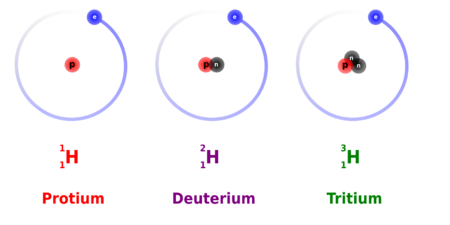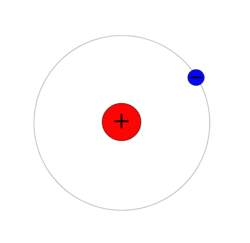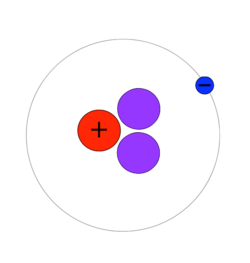Physics:Isotopes of hydrogen
| |||||||||||||||||||||||||||||
| Standard atomic weight Ar, standard(H) |
| ||||||||||||||||||||||||||||
|---|---|---|---|---|---|---|---|---|---|---|---|---|---|---|---|---|---|---|---|---|---|---|---|---|---|---|---|---|---|
Hydrogen (1H) has three naturally occurring isotopes, sometimes denoted 1H, 2H, and 3H. 1H and 2H are stable, while 3H has a half-life of 12.32(2) years.[2][nb 1] Heavier isotopes also exist, all of which are synthetic and have a half-life of less than one zeptosecond (10−21 s).[3][4] Of these, 5H is the least stable, while 7H is the most.
Hydrogen is the only element whose isotopes have different names that remain in common use today: the 2H (or hydrogen-2) isotope is deuterium[5] and the 3H (or hydrogen-3) isotope is tritium.[6] The symbols D and T are sometimes used for deuterium and tritium. The IUPAC accepts the D and T symbols, but recommends using standard isotopic symbols (2H and 3H) instead to avoid confusion in the alphabetic sorting of chemical formulas.[7] The isotope 1H, with no neutrons, is sometimes called protium.[8] (During the early study of radioactivity, some other heavy radioactive isotopes were given names, but such names are rarely used today.)

List of isotopes
Note that "y" means "year", but "ys" means "yoctosecond" (10−24 second).
| Nuclide |
Z | N | Isotopic mass (u) [n 1] |
Half-life |
Decay mode [n 2] |
Daughter isotope [n 3] |
Spin and parity [n 4][n 5] |
Physics:Natural abundance (mole fraction) | Note | |
|---|---|---|---|---|---|---|---|---|---|---|
| Normal proportion | Range of variation | |||||||||
| 1H | 1 | 0 | 1.007825031898(14) | Stable[n 6][n 7] | 1/2+ | [0.99972, 0.99999][9] | Protium | |||
| 2H (D)[n 8][n 9] | 1 | 1 | 2.014101777844(15) | Stable | 1+ | [0.00001, 0.00028][9] | Deuterium | |||
| 3H (T)[n 10] | 1 | 2 | 3.016049281320(81) | 12.32(2) y | β− | 3He | 1/2+ | Trace[n 11] | Tritium | |
| 4H | 1 | 3 | 4.02643(11) | 139(10) ys | n | 3H | 2− | |||
| 5H | 1 | 4 | 5.03531(10) | 86(6) ys | 2n | 3H | (1/2+) | |||
| 6H | 1 | 5 | 6.04496(27) | 294(67) ys | n ?[n 12] | 5H ? | 2−# | |||
| 3n ?[n 12] | 3H ? | |||||||||
| 7H | 1 | 6 | 7.052750(108)# | 652(558) ys | 2n ?[n 12] | 5H ? | 1/2+# | |||
- ↑ ( ) – Uncertainty (1σ) is given in concise form in parentheses after the corresponding last digits.
- ↑
Modes of decay:
n: Neutron emission - ↑ Bold symbol as daughter – Daughter product is stable.
- ↑ ( ) spin value – Indicates spin with weak assignment arguments.
- ↑ # – Values marked # are not purely derived from experimental data, but at least partly from trends of neighboring nuclides (TNN).
- ↑ Unless proton decay occurs.
- ↑ This and 3He are the only stable nuclides with more protons than neutrons.
- ↑ Produced during Big Bang nucleosynthesis.
- ↑ One of the few stable odd-odd nuclei
- ↑ Produced during Big Bang nucleosynthesis, but not primordial, as all such atoms have since decayed to 3He.
- ↑ Tritium occurs naturally as a cosmogenic nuclide.
- ↑ 12.0 12.1 12.2 Decay mode shown is energetically allowed, but has not been experimentally observed to occur in this nuclide.
Hydrogen-1 (protium)
1H (atomic mass 1.007825031898(14) Da) is the most common hydrogen isotope, with an abundance of more than 99.98%. Because the nucleus of this isotope consists of only a single proton, it is given the formal name protium.
The proton has never been observed to decay, and hydrogen-1 is therefore considered a stable isotope. Some grand unified theories proposed in the 1970s predict that proton decay can occur with a half-life between 1028 and 1036 years.[10] If this prediction is found to be true, then hydrogen-1 (and indeed all nuclei now believed to be stable) are only observationally stable. (As of 2018), experiments have shown that the minimum mean lifetime of the proton is in excess of 3.6×1029 years.[11]
Hydrogen-2 (deuterium)
2H (atomic mass 2.014101777844(15) Da), the other stable hydrogen isotope, is known as deuterium and contains one proton and one neutron in its nucleus. The nucleus of deuterium is called a deuteron. Deuterium comprises 0.0026–0.0184% (26 ppm or 184 ppm ; by population, not by mass) of hydrogen samples on Earth, with the lower number tending to be found in samples of hydrogen gas and the higher enrichment (0.015% or 150 ppm) typical of ocean water. Deuterium on Earth has been enriched with respect to its initial concentration in the Big Bang and the outer solar system (about 27 ppm, by atom fraction) and its concentration in older parts of the Milky Way galaxy (about 0.0023%, or 23 ppm). Presumably the differential concentration of deuterium in the inner solar system is due to the lower volatility of deuterium gas and compounds, enriching deuterium fractions in comets and planets exposed to significant heat from the Sun over billions of years of solar system evolution.
Deuterium is not radioactive, and does not represent a significant toxicity hazard. Water enriched in molecules that include deuterium instead of protium is called heavy water. Deuterium and its compounds are used as a non-radioactive label in chemical experiments and in solvents for 1H-nuclear magnetic resonance spectroscopy. Heavy water is used as a neutron moderator and coolant for nuclear reactors. Deuterium is also a potential fuel for commercial nuclear fusion.
Hydrogen-3 (tritium)
3H (atomic mass 3.016049281320(81) Da) is known as tritium and contains one proton and two neutrons in its nucleus. It is radioactive, decaying into helium-3 through β− decay with a half-life of 12.32(2) years.[nb 1][2] Trace amounts of tritium occur naturally because of the interaction of cosmic rays with atmospheric gases. Tritium has also been released during nuclear weapons tests. It is used in thermonuclear fusion weapons, as a tracer in isotope geochemistry, and specialized in self-powered lighting devices.
The most common method of producing tritium is by bombarding a natural isotope of lithium, lithium-6, with neutrons in a nuclear reactor.
Tritium can be used in chemical and biological labeling experiments as a radioactive tracer.[12][13] D-T nuclear fusion uses tritium as its main reactant, along with deuterium, liberating energy through the loss of mass when the two nuclei collide and fuse at high temperatures.
Hydrogen-4
4H (atomic mass 4.02643(11)) contains one proton and three neutrons in its nucleus. It is a highly unstable isotope of hydrogen. It has been synthesized in the laboratory by bombarding tritium with fast-moving deuterium nuclei.[14] In this experiment, the tritium nucleus captured a neutron from the fast-moving deuterium nucleus. The presence of the hydrogen-4 was deduced by detecting the emitted protons. It decays through neutron emission into hydrogen-3 (tritium) with a half-life of 139(10) ys (or 1.39(10)×10−22 s).
In the 1955 satirical novel The Mouse That Roared, the name quadium was given to the hydrogen-4 isotope that powered the Q-bomb that the Duchy of Grand Fenwick captured from the United States.
Hydrogen-5
5H (atomic mass 5.03531(10)) is a highly unstable isotope of hydrogen. The nucleus consists of a proton and four neutrons. It has been synthesized in the laboratory by bombarding tritium with fast-moving tritium nuclei.[14][15] In this experiment, one tritium nucleus captures two neutrons from the other, becoming a nucleus with one proton and four neutrons. The remaining proton may be detected, and the existence of hydrogen-5 deduced. It decays through double neutron emission into hydrogen-3 (tritium) and has a half-life of 86(6) ys (8.6(6)×10−23 s) – the shortest half-life of any known nuclide.[2]
Hydrogen-6
6H (atomic mass 6.04496(27)) consists of a proton and five neutrons. It decays either through triple neutron emission into hydrogen-3 (tritium) or quadruple neutron emission into hydrogen-2 (deuterium) and has a half-life of 294(67) ys (2.94(67)×10−22 s).
Hydrogen-7
7H (atomic mass 7.05275(108)) consists of a proton and six neutrons. It was first synthesized in 2003 by a group of Russian, Japanese and French scientists at RIKEN's Radioactive Isotope Beam Factory by bombarding hydrogen with helium-8 atoms. In the resulting reaction, all six of the helium-8 neutrons were donated to the hydrogen's nucleus. The two remaining protons were detected by the "RIKEN telescope", a device composed of several layers of sensors, positioned behind the target of the RI Beam cyclotron.[4] Hydrogen-7 has a half-life of 652(558) ys (6.52(558)×10−22 s).[2]
Decay chains
The majority of heavy hydrogen isotopes decay directly to 3H, which then decays to the stable isotope 3He. However, 6H has occasionally been observed to decay directly to stable 2H.
- [math]\displaystyle{ \begin{array}{rcl}\\ \ce{^3_1H} &\ce{-\gt [12.32\ \ce{y}]} &\ce{{^3_2He} + e^-} \\ \ce{^4_1H} &\ce{-\gt [139\ \ce{ys}]} &\ce{{^3_1H} + {^1_0n}} \\ \ce{^5_1H} &\ce{-\gt [86\ \ce{ys}]} &\ce{{^3_1H} + {2^1_0n}} \\ \ce{^6_1H} &\ce{-\gt [294\ \ce{ys}]} &\ce{{^3_1H} + {3^1_0n}} \\ \ce{^6_1H} &\ce{-\gt [294\ \ce{ys}]} &\ce{{^2_1H} + {4^1_0n}} \\ \ce{^7_1H} &\ce{-\gt [652\ \ce{ys}]} &\ce{{^3_1H} + {4^1_0n}} \\{} \end{array} }[/math]
Decay times are in yoctoseconds (10−24 s) for all these isotopes except 3H, which is expressed in years.
See also
- Hydrogen isotope biogeochemistry
- Hydrogen-4.1 (Muonic helium)
- Muonium – acts like an exotic light isotope of hydrogen
Notes
- ↑ 1.0 1.1 Note that NUBASE2020 uses the tropical year to convert between years and other units of time, not the Gregorian year. The relationship between years and other time units in NUBASE2020 is as follows: 1 y = 365.2422 d = 31 556 926 s
References
- ↑ Meija, Juris; Coplen, Tyler B.; Berglund, Michael; Brand, Willi A.; De Bièvre, Paul; Gröning, Manfred; Holden, Norman E.; Irrgeher, Johanna et al. (2016). "Atomic weights of the elements 2013 (IUPAC Technical Report)". Pure and Applied Chemistry 88 (3): 265–91. doi:10.1515/pac-2015-0305.
- ↑ 2.0 2.1 2.2 2.3 Kondev, F. G.; Wang, M.; Huang, W. J.; Naimi, S.; Audi, G. (March 2021). "The NUBASE2020 evaluation of nuclear physics properties \ast" (in en). Chinese Physics C 45 (3): 030001. doi:10.1088/1674-1137/abddae. ISSN 1674-1137. Bibcode: 2021ChPhC..45c0001K.
- ↑ Y. B. Gurov (2004). "Spectroscopy of superheavy hydrogen isotopes in stopped-pion absorption by nuclei". Physics of Atomic Nuclei 68 (3): 491–497. doi:10.1134/1.1891200. Bibcode: 2005PAN....68..491G.
- ↑ 4.0 4.1 A. A. Korsheninnikov (2003). "Experimental Evidence for the Existence of 7H and for a Specific Structure of 8He". Physical Review Letters 90 (8): 082501. doi:10.1103/PhysRevLett.90.082501. PMID 12633420. Bibcode: 2003PhRvL..90h2501K.
- ↑ IUPAC, Compendium of Chemical Terminology, 2nd ed. (the "Gold Book") (1997). Online corrected version: (2006–) "deuterium". doi:10.1351/goldbook.D01648
- ↑ IUPAC, Compendium of Chemical Terminology, 2nd ed. (the "Gold Book") (1997). Online corrected version: (2006–) "tritium". doi:10.1351/goldbook.T06513
- ↑ International Union of Pure and Applied Chemistry (2005). Nomenclature of Inorganic Chemistry (IUPAC Recommendations 2005). Cambridge (UK): RSC–IUPAC. ISBN:0-85404-438-8. p. 48. Electronic version.
- ↑ IUPAC, Compendium of Chemical Terminology, 2nd ed. (the "Gold Book") (1997). Online corrected version: (2006–) "protium". doi:10.1351/goldbook.P04903
- ↑ 9.0 9.1 "Atomic Weight of Hydrogen". http://ciaaw.org/hydrogen.htm.
- ↑ Ed Kearns (2009). "Grand Unified Theories and Proton Decay". Boston University. p. 15. http://physics.bu.edu/NEPPSR/TALKS-2009/Kearns_GUTs_ProtonDecay.pdf.
- ↑ The SNO+ Collaboration; Anderson, M.; Andringa, S.; Arushanova, E.; Asahi, S.; Askins, M.; Auty, D. J.; Back, A. R. et al. (2019-02-20). "Search for invisible modes of nucleon decay in water with the SNO+ detector". Physical Review D 99 (3): 032008. doi:10.1103/PhysRevD.99.032008. Bibcode: 2019PhRvD..99c2008A.
- ↑ "SARS-CoV-2 mRNA Vaccine (BNT162, PF-07302048)". 2.6.5.5B, pp. 6–8. http://www.pmda.go.jp/drugs/2021/P20210212001/672212000_30300AMX00231_I100_1.pdf#page=16. "[3H]-Labelled LNP-mRNA"
- ↑ Green, Joanne Balmer; Green, Michael H. (2020). "Vitamin A Absorption Determined in Rats Using a Plasma Isotope Ratio Method". The Journal of Nutrition 150 (7): 1977–1981. doi:10.1093/jn/nxaa092. PMID 32271921.
- ↑ 14.0 14.1 G. M. Ter-Akopian (2002). "Hydrogen-4 and Hydrogen-5 from t+t and t+d transfer reactions studied with a 57.5-MeV triton beam". AIP Conference Proceedings 610: 920–924. doi:10.1063/1.1470062. Bibcode: 2002AIPC..610..920T.
- ↑ A. A. Korsheninnikov (2001). "Superheavy Hydrogen 5H". Physical Review Letters 87 (9): 92501. doi:10.1103/PhysRevLett.87.092501. PMID 11531562. Bibcode: 2001PhRvL..87i2501K.
Further reading
- Dumé, B. (7 March 2003). "Hydrogen-7 makes its debut". Physics World. http://physicsworld.com/cws/article/news/2003/mar/07/hydrogen-7-makes-its-debut.
 |




